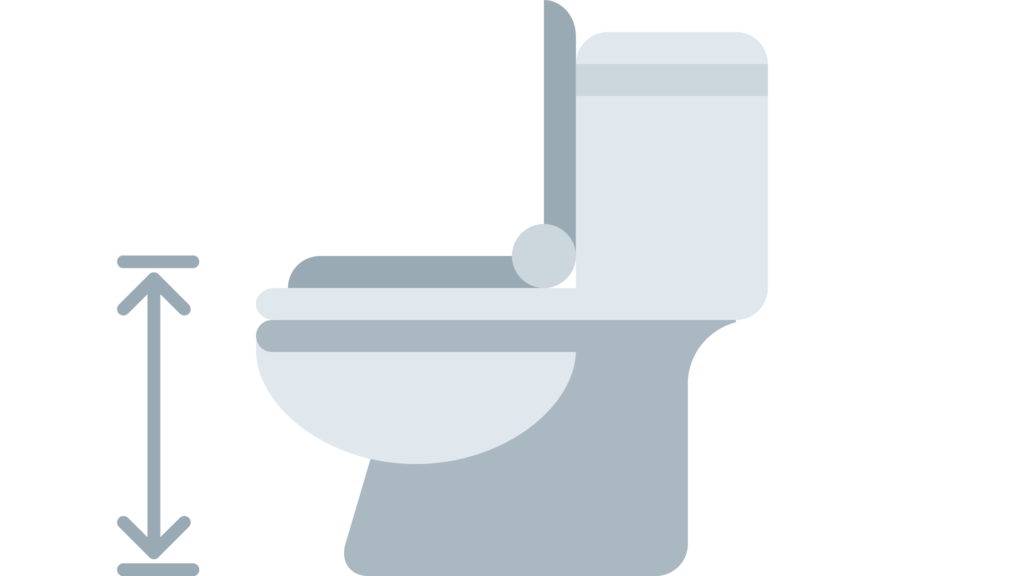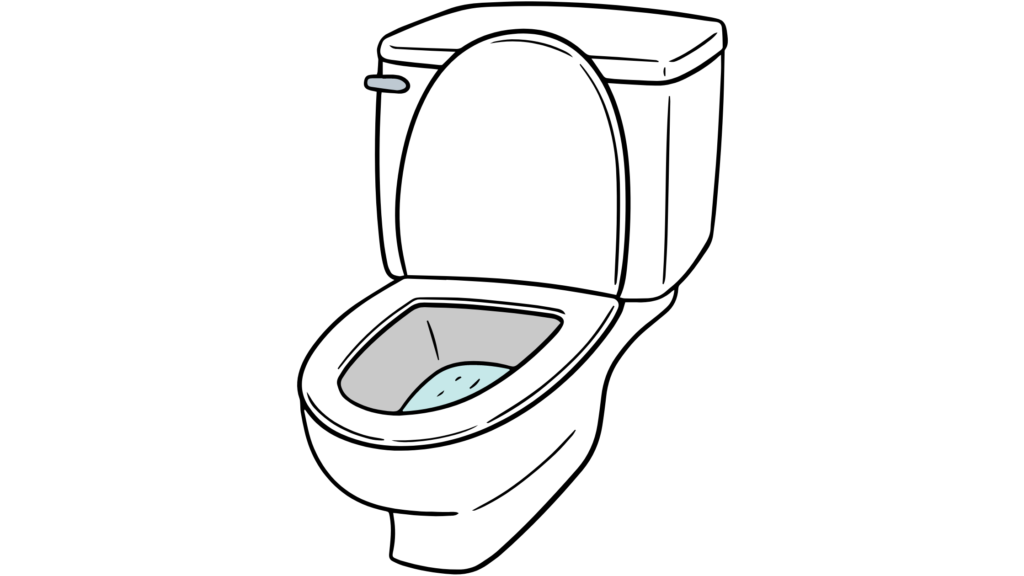One of the most overlooked aspects when designing a bathroom is selecting an appropriate toilet height. Choosing the right toilet height can be especially tricky, as comfort and functionality vary greatly depending on your size and shape. Learn how to pick the perfect toilet seat for your home with this beginner’s guide that outlines important factors like room size, measurements, ADA compliance requirements, and more!
What is toilet height?

So, what exactly is toilet height? To put it simply, the toilet height is the distance from the floor to the top of the toilet seat.
The height of a toilet can be important for people buying toilets because it can impact the comfort and accessibility of the toilet.
If the toilet height is too low, it can be difficult for people with mobility issues or injuries to use, and it can also be uncomfortable for taller individuals.
On the other hand, if the toilet height is too high, it can be difficult for shorter individuals or children to use.
Choosing a toilet with an appropriate height can help ensure that the toilet is comfortable and accessible for all users. Additionally, choosing a toilet with an appropriate height can also help prevent falls and accidents.
The various toilet heights available on the market
| Toilet Height (Inches) | Description |
|---|---|
| Standard Height (14-15) | The most common toilet height, suitable for most adults |
| Comfort Height (16-17) | Designed to be more comfortable for taller individuals or those with mobility issues |
| Barrier-Free (17-19) | Designed for use in facilities with ADA compliance requirements |
| Handicap Accessible (17-19) | Designed for use in facilities with ADA compliance requirements |
| Children’s (10-13) | Designed for use by children or for use in facilities such as schools or daycares |
Standard toilet height

The standard toilet seat height is typically between 14 and 15 inches, which falls within the range recommended by most health organizations. This height is generally considered to be a good balance between comfort and accessibility for people of all sizes and physical abilities. In most homes, the standard toilet height is often the one that is installed when a new toilet is purchased.
Benefits of standard toilet height
- Ease of use: Standard toilet height is the most common and widely used height, making it easy to find toilet seat covers and other accessories that will fit properly.
- Comfort: Standard toilet height is comfortable for most people, as it allows for proper leg extension and a natural seated position.
- Accessibility: Standard toilet height is also generally more accessible for people with mobility issues, as it is not as low as some other toilet heights and does not require as much effort to stand up from.
- Cost: Standard toilet height is often less expensive than other toilet heights, as it is more widely available and commonly used.
Who is a standard toilet height suitable for?
Standard toilet height is suitable for most people. This includes people who are comfortable with a lower seat height, as well as people who do not have mobility issues or need to consider accessibility in their bathroom design. Standard toilet height is also a good choice for people who are looking for a traditional toilet that is both functional and affordable.
Comfort height toilet
Comfort height toilets, also called “chair height” or “right height” toilets, are taller than regular toilets. They have a seat height of 16-17 inches, which is about 2-3 inches higher than a standard toilet. These toilets are more comfortable and easier to use for people who have difficulty sitting down or standing up from a regular toilet seat. Comfort height toilets are often recommended for elderly or disabled individuals, but they are also popular with people of all ages who want a more comfortable toilet experience.
Benefits of comfort height toilet
There are several benefits to using a comfort height toilet:
- Improved accessibility: Comfort height toilets are often easier for people with disabilities or mobility issues to use because the higher seat position reduces the need to bend down.
- Reduced strain on joints: The higher seat position can also reduce strain on the knees, hips, and back, which can be especially beneficial for people with arthritis or other joint issues.
- Increased comfort: Many people find that the higher seat position is more comfortable for extended periods of sitting, such as when reading or using a mobile device.
- Aesthetically pleasing: Comfort height toilets can also add a modern, stylish touch to a bathroom design.

Who is a comfort height toilet suitable for?
Comfort height toilets are suitable for people who have mobility issues, such as those with arthritis or hip problems. These toilet seats are easier to sit down on and stand up from. Taller individuals who may find standard height toilets too low may also want to use comfort height toilets.
Is universal height the same as comfort height?
Universal height and comfort height are terms that are used to refer to toilet bowls that are taller than the standard height of 14-15 inches. These taller toilet bowls are typically around 16-17 inches in height, which is considered more comfortable and easier to use for many people, particularly those with mobility issues or disabilities. However, it’s important to note that there is no official or standardized definition of what constitutes a universal or comfort height toilet, so the exact measurements may vary slightly between different brands and models.
ADA-compliant toilet

ADA-compliant toilets are toilets that meet the standards set by the Americans with Disabilities Act (ADA) for accessibility in public buildings. These standards specify that toilet seats should be between 17 and 19 inches off the ground, and the toilet should have clear floor space in front of it for wheelchair users. ADA-compliant toilets also typically have features such as handrails and higher flush levers to make them easier to use for people with disabilities. These toilets are often referred to as “handicap accessible” or “barrier-free” toilets.
Benefits of ADA-compliant toilet
ADA-compliant toilets have a number of benefits, both for people with disabilities and for the general population. Some of the benefits include:
- Improved accessibility: ADA-compliant toilets are designed to be accessible to people with disabilities, including those who use wheelchairs or have mobility impairments. This can make it easier for people with disabilities to use the bathroom and feel more independent.
- Increased safety: ADA-compliant toilets are designed to reduce the risk of falls and other accidents. They often have features like grab bars, which can help people with mobility impairments to lower themselves onto the toilet or to stand up again.
- Enhanced comfort: ADA-compliant toilets are typically designed to be more comfortable to use, with features like a higher seat height and a more ergonomic design. This can make them more comfortable for people with disabilities, as well as for older adults and others who may have difficulty using standard toilets.
- Greater convenience: ADA-compliant toilets often have additional features like hands-free flushing and automatic seat covers, which can make them more convenient to use. This can be especially beneficial for people with mobility impairments who may have difficulty reaching the flush lever or seat cover.
- Improved hygiene: Some ADA-compliant toilets have features like self-cleaning surfaces or hands-free flushing that can help to improve hygiene and reduce the risk of cross-contamination.
Who is an ADA-compliant toilet suitable for?
ADA-compliant toilets are designed to be accessible and usable for people with disabilities, including those who use wheelchairs or have mobility impairments. However, they can also be beneficial for a wide range of other people, including:
- Older adults: As people age, they may experience a decline in mobility or other physical challenges that can make it difficult to use standard toilets. ADA-compliant toilets, with their higher seat heights and other features, can be more comfortable and easier to use for older adults.
- Children: Some children, especially those with disabilities or special needs, may have difficulty using standard toilets. ADA-compliant toilets can be more accessible and user-friendly for children.
- Pregnant women: Pregnant women may find it more comfortable to use ADA-compliant toilets, due to their higher seat heights and other features.
- People with arthritis: Arthritis and other conditions that affect the joints can make it difficult to lower oneself onto a standard toilet or to stand up again. ADA-compliant toilets, with their higher seat heights and grab bars, can be more comfortable and easier to use for people with these conditions.
Overall, ADA-compliant toilets can be suitable for anyone who may have difficulty using standard toilets, whether due to a disability, an age-related condition, or some other factor.
Factors to consider when choosing a toilet height
- Personal preference and comfort level – When choosing a toilet height, it is important to consider your personal preferences and comfort level. Some people may prefer a lower seat height, while others may find that a higher seat height makes using the toilet easier and more comfortable.
- Budget – Although ADA-compliant toilets are typically more expensive than standard toilets, there are also some less expensive options available. When shopping for a toilet height, it is important to consider your budget and find the best fit within your price range.
- Space constraints – If you are limited on space in your bathroom, it is important to consider the dimensions of available toilets as well as any other factors that may impact the installation process (such as piping). In some cases, a lower seat height may be a better choice if space is limited.
- Age and physical ability – Another factor to consider is your age and physical ability. This can help you to determine which seat height will be most comfortable and accessible for you.
FAQs
Can I adjust the height of my toilet?
It may be possible to adjust the height of your toilet. One way to get an elevated toilet seat is by using a toilet riser. A toilet riser is a small platform that sits on top of the toilet, raising its height and making it easier to use. Toilet risers are available in a wide range of heights, allowing you to find one that will match your needs.
How do I measure the correct toilet height for my needs?
To measure your toilet height, use a tape measure and measure from the floor to the top of your toilet at its highest point. You may also want to consider factors such as your body type and any physical limitations or disabilities, which can help you to determine what height will be most comfortable and accessible for you. To get more specific recommendations tailored to your needs, consult a medical professional or another healthcare provider.
Can I install a taller toilet in an older home with lower plumbing connections?
It may be possible to install a taller toilet in an older home with lower plumbing connections, but it can be a bit more challenging than installing a standard-height toilet. In order to do so, you may need to make some modifications to your plumbing system, such as raising the water supply line or the drain pipe. This can be a complex and potentially costly process, and it’s generally best to have it done by a professional plumber.
Are there toilet height regulations in commercial buildings or public restrooms?

Yes, in many cases there are regulations around the height of toilets in commercial buildings and public restrooms. These requirements are typically determined by ADA guidelines, which set minimum standards for accessibility and usability. As such, most commercial buildings and public restrooms will have toilet heights that comply with these guidelines.
According to the ADA guidelines, the minimum height for toilet seat rim in a public restroom or commercial building should be 17 inches (43 cm) above the finished floor. This is measured from the top of the seat rim to the finished floor, and is intended to provide sufficient clearance for people who use wheelchairs or other mobility aids.
The ADA guidelines also specify other requirements for toilet height and accessibility, including the height and location of grab bars, the size of the clear floor space in front of the toilet, and the location of the flush control. These requirements are intended to ensure that toilets in commercial buildings and public restrooms are accessible and usable for people with disabilities.